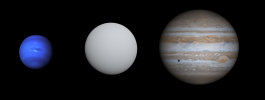Astronomy:CoRoT-8b
From HandWiki
Short description: Extrasolar planet in the constellation Aquila
 CoRoT-8b compared to Jupiter and Neptune. | |
| Discovery[1] | |
|---|---|
| Discovered by | Borde et al. |
| Discovery site | CoRoT space telescope |
| Discovery date | 12 April 2010 |
| Transit | |
| Orbital characteristics | |
| 0.0636 ± 0.0014 AU (9,510,000 ± 210,000 km)[2] | |
| Eccentricity | <0.19[3] |
| Orbital period | 6.212445±0.000007 d[2] |
| Inclination | 88.18°±0.08°[2] |
| astron|astron|helion}} | 2,454,239.03317±0.00049 JD[2] |
| Semi-amplitude | 27.6+5.8 −4.7 m/s[3] |
| Star | CoRoT-8 (ru) |
| Physical characteristics | |
| Mean radius | 0.619+0.016 −0.017 RJ[2] |
| Mass | 0.218±0.034 MJ[2] |
| Mean density | 1.1±0.2 g/cm3[2] |
| Physics | 870 ± 14 K (1,106.3 ± 25.2 °F; 596.9 ± 14.0 °C)[2] |
CoRoT-8b is a transiting exoplanet orbiting the K-type main sequence star CoRoT-8 1,050 light years away in the equatorial constellation Aquila. The planet was discovered in April 2010 by the CoRoT telescope.
Discovery
This planet was discovered using the transit method, which detects planet via eclipses. The discovery paper's abstract states that CoRoT-8b is extremely dense compared to Saturn.
Properties
CoRoT-8b has 21.8% Jupiter's mass, and due to its close orbit, a radius 61.9% that of Jupiter. This classifies the planet as a hot Saturn. Despite the bloated radius, the planet is extremely dense, with it being 1.1 times greater than water's; CoRoT-8b has a temperature of 870 K from its 6-day orbit.
References
- ↑ Bordé, P. et al. (September 2010). "Transiting exoplanets from the CoRoT space mission. XI. CoRoT-8b: a hot and dense sub-Saturn around a K1 dwarf". Astronomy and Astrophysics 520: A66. doi:10.1051/0004-6361/201014775. ISSN 0004-6361. Bibcode: 2010A&A...520A..66B.
- ↑ 2.0 2.1 2.2 2.3 2.4 2.5 2.6 2.7 Raetz, St; Heras, A. M.; Fernández, M.; Casanova, V.; Marka, C. (February 2019). "Transit analysis of the CoRoT-5, CoRoT-8, CoRoT-12, CoRoT-18, CoRoT-20, and CoRoT-27 systems with combined ground- and space-based photometry". Monthly Notices of the Royal Astronomical Society 483 (1): 824–839. doi:10.1093/mnras/sty3085. ISSN 0035-8711. Bibcode: 2019MNRAS.483..824R.
- ↑ 3.0 3.1 Bonomo, A. S. et al. (June 2017). "The GAPS Programme with HARPS-N at TNG . XIV. Investigating giant planet migration history via improved eccentricity and mass determination for 231 transiting planets". Astronomy and Astrophysics 602: A107. doi:10.1051/0004-6361/201629882. ISSN 0004-6361. Bibcode: 2017A&A...602A.107B.
 |


